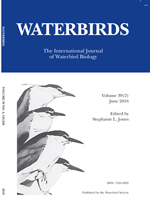Numbers, densities, and sex ratios of Yellow Rails (Coturnicops noveboracensis) wintering at Red Slough Wildlife Management Area in McCurtain County, Oklahoma, USA, were approximated and compared to estimates from birds wintering in coastal Texas, USA. Deuterium (δD) and sulfur (δ34S) values from rectrices of birds wintering in Oklahoma and in Texas were also examined to determine where the birds bred. Yellow Rails in Oklahoma from October 2009 through April 2010 were banded. Fifty-six Yellow Rails were captured, and the population was estimated to consist of 90.3 ± 25.5 birds, or 5.3 ± 1.5 rails * ha-1, which is similar to the published density of Yellow Rails in coastal Texas. Sex ratios did not differ from an expected 1:1 male:female ratio and did not differ between Oklahoma and Texas. Rectrices from Texas (n = 40) and Oklahoma (n = 32) had similar δD values and were broadly consistent with published δD values from southeastern Alberta to James Bay in Ontario and Quebec, Canada. The δ34S analysis from Texas (n = 4) and Oklahoma (n = 35) showed only two birds, both from Texas, with enriched δ34S values, suggesting that most birds from Texas and Oklahoma bred in interior Canadian marshes. Although the sample size was small, these results suggest interior overwintering sites contain similar densities to coastal sites.
How to translate text using browser tools
1 June 2016
A Comparison of the Origins of Yellow Rails (Coturnicops noveboracensis) Wintering in Oklahoma and Texas, USA
Christopher J. Butler,
Jennifer K. Wilson,
Stephen R. Frazee,
Jeffrey F. Kelly

Waterbirds
Vol. 39 • No. 2
June 2016
Vol. 39 • No. 2
June 2016
Coturnicops noveboracensis
density
deuterium
population estimate
stable isotope
sulfur
winter




